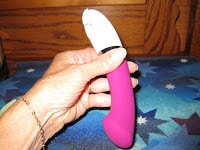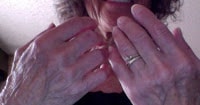Things You’ll Never Hear Him Say When He Sees You Naked
 |
| Photo by Ruth Lefkowitz |
I discover it’s not just single women: I had a conversation with a man about my age who is no longer having sex with his wife because she’s too embarrassed about her weight gain to be naked with him.
Other men tell me similar stories — that their wives hide their bodies, and the men miss the sex and the intimacy, but don’t know how to ease their wives past their distaste for their bodies.
I’d like to talk to both genders here:
Finally, after meeting so many frogs (and not even tempted to kiss any of them), you’ve met a man who makes your heart flutter big time. You’ve flirted, you’ve gone on a few dates, you’ve talked half the night, you’ve laughed at his jokes and he at yours. On your last date, you kissed… and kissed. His hands went exploring, so did yours, and you know that on the next date, more than your lipstick will come off. You’ve even had the Condom Conversation.
But, your inner worrier keeps asking you, what if he sees your body and heads for the hills?
You’ve got to trust me on this, he’s not going to say or even think any of the following:
- “Oh, gee, you have so many wrinkles!”
- “You’d be so pretty if you lost weight.”
- “Huh—I thought you looked younger with clothes on.”
- “I like firmer butts and perkier breasts.”
- “Uh, I gotta go now.”
No, whether or not he voices it out loud or conveys it with a smile or melting eyes, here’s what he’s thinking:
Partnered women: Does your husband have the same body as when you first dated? I doubt it. Realize that your man wants you, wants the bonding with you, wants the sexual pleasure with you. Instead of asking him, “Do I look fat?” try asking, “What do you find the sexiest part of my body?” His answer might surprise you, and I’ll bet he’ll be delighted that you asked.
Men: You may not realize how insecure we women are about our bodies. We need to hear from you that you find us sexy, alluring, beautiful. If you think our breasts are gorgeous, or our rear view turns you on, please tell us. Even an “I could gaze into your eyes forever” will make our hearts flutter. We need you to help us affirm our bodies. A hefty dose of romance does wonders for us, too!
We women are our own worst critics, always have been. Remember those teenage pimples? Those worries about our shape and smell? Let’s decide, once and for all, that our bodies are just right, capably of visually delighting a partner and of bringing us both great pleasure.
If we can’t do that at this time of life, when can we? Even if we don’t fully believe it, acting “as if” we’re proud of our bodies will help make it so.
So when it’s time for that get-naked date, prepare with some gorgeous lingerie, dim the lights if you feel the need, but don’t black out the view (candles are sexy and flattering), have lubricant handy, and enjoy.
I’d love to hear from both women and men about this topic! Please comment.
This post was originally published in a slightly different form 11/8/11. I expanded and updated it 11/20/2012.
When the man no longer wants sex: guest post by Jason Kae-Smith
He’s Just Not That Into It
 |
| Jason Kae-Smith |
After months of his wife’s pleading and an eventual ultimatum, “Ted” (not his real name) found himself sitting somewhere he’d never imagined—the office of a sex therapist. The three-year journey leading up to this day was painful; a strained effort along a cumbersome path littered with resentments, accusations, and much confusion.
As Ted told his therapist, “I just don’t get it. I love my wife. She’s intelligent, she’s compassionate. She’s a wonderful mother to our children. She’s my best friend and I love hanging out with her. I just don’t want to have sex with her anymore.”
It turns out Ted isn’t alone. In the United States, there are an estimated 10 million men in sexless, heterosexual marriages. And while many would assume that women’s lack of desire is the main culprit, recent trends indicate that it is just as likely the men who have lost that loving feeling. Many sex therapists are seeing an increase in heterosexual men coming to them for problems with desire, some noting that the percentage of men with low desire now outweighs the percentage of women.
 Calgary sex therapist David Hersh, EdD, observes, “When I first started and I would see couples with discordant desire, it was mostly the woman who wasn’t interested. Now about 55% of these couples are seeing me because the man has lost interest.” Several therapists queried confirmed a similar trend in their practices.
Calgary sex therapist David Hersh, EdD, observes, “When I first started and I would see couples with discordant desire, it was mostly the woman who wasn’t interested. Now about 55% of these couples are seeing me because the man has lost interest.” Several therapists queried confirmed a similar trend in their practices.
It’s not clear if there are actually more men experiencing low desire or if it’s just that more men are now seeking help. Hersh says he believes the latter is the case. “Now, men are more informed about the condition. Traditionally there was a double standard where ‘real men’ always wanted to have sex. But you’re not so strange anymore if you don’t want it.”
 |
| Ricky Siegel |
Sex therapist Ricky Siegel agrees, stating, “I think there’s little doubt that the most obvious factor to the issue of low desire in men is that ‘Real men are not supposed to have low desire!’ So where it has become an acceptable script for women, it’s one of the things that men suffered about in quiet shame.”
In 2008, Bob Berkowitz and Susan Yager-Berkowitz published the results of their survey of over 1300 men who identified as no longer having sex with their spouses. The respondents listed several reasons for their loss of interest in sex, some of which included emotional struggles with things like depression and anger. Others reported they began avoiding sex because of problems with sexual functioning and eventually lost interest in sex altogether. And while many men initially suspect their loss of libido might be a result of low testosterone, research findings, such as those reported by Sari van Anders in the May, 2012 issue of Archives of Sexual Behavior, continue to suggest this is more often not the case.
Despite his assertion that everything was okay, “Derek” told his therapist that he reluctantly agreed to a session because, “I love my wife and I will do this if she feels it is important.” Derek’s wife “Cindy” was concerned because recently Derek had stopped initiating sex with her, something that she said was “unusual” for him.
Derek said was likely due to stress or perhaps “getting a little older” but when Cindy was invited to talk about experiencing her own sexuality, a different kind of narrative began to emerge. Cindy stated that in the beginning of her relationship with Derek, “Sex was okay but I was never all that into it.” But she added, “Lately, something happened. And now it’s like I can’t wait to jump on this man.”
It turns out that “something” was her reading the best-selling 50 Shades trilogy. Cindy’s sister had turned her onto the books and to Cindy’s surprise the books turned her on, prompting her to embrace and embody her sexuality like never before. After some contemplation, Derek finally conceded that Cindy’s sudden interest in sex had a surprising blanketing effect on his desire for her. “I don’t get it,” he said. “I mean, this is what I always wanted. But when it happened, and all of a sudden she’s wanting to go to the sex store and buy toys and try new things—I don’t know, I guess it kind of turned me off.”
When it comes to treatment, experts often recommend a physical examination (just to be sure) and then consultation with a sex therapist. But what can therapists do to help men get their mojo back? Fortunately, those who practice and write about clinical sexology are continually developing ways for therapists to think about and respond to requests for help. The traditional model is to look at problems in the relationship first. One of the current trends in therapy is to go right to the sex.
As for Ted, the specific course of his future sessions will be guided by the choices he and his therapist make as their therapy conversations unfold. Today’s session marks a turning point in his journey, a change of direction toward the possibility of getting out from underneath the weight of low desire.
“This was good,” he told his therapist at the conclusion of their meeting. “It feels good to get this off my chest.” He added, “I guess I feel a lot more hopeful, like this isn’t just the way it has to be when you get married and are with someone for a long time.”
Jason Kae-Smith is a certified sex therapist with a practice in Grand Rapids, MI. Among other things, he is interested in ways people are able to give value to sexual pleasure throughout their lifetimes. The article from which this is excerpted first appeared in Contemporary Sexuality, the journal of American Association of Sexuality Educators
Counselors & Therapists (AASECT).
LELO’s GIGI: slim, smooth, sensual
 This review was originally written in 2009. I updated it November
This review was originally written in 2009. I updated it November2012. GIGI has become a favorite sex buddy, one I reach for
regularly even though I have many dozen to choose from after reviewing
sex toys from a senior perspective for four years! Sex-toy designers are catching on to the notion that sexual enhancement products (okay, vibrators) that work best for women’s anatomy might not be in the shape of a penis (or dolphin, rabbit, and so on) but rather a design that actually fits the way we’re shaped and makes contact with our hot spots most effectively. As we age, our bed buddy also needs to be pleasant to hold for an extended time without inflaming arthritic wrists or burning out before we do.
I’ve had the pleasure of testing the lovely GIGI “sensual pleasure object” from LELO. The rechargeable GIGI specializes in G-spot stimulation, and indeed the flared shape at the tip easily locates, stimulates, and hugs my G-spot. Great design!
It’s also dandy for clitoral stimulation. If you like both, just alternate placement, or use a clitoral vibrator while the GIGI is vaginally inserted — which is what I do. The curved shape makes it easy to keep GIGI inserted and out of the way when you’re using another vibrator on your clitoris.
I love the shape and size — not girthy (so helpful for post-menopausal vaginas), shaped for easy insertion, flared for the best sensation. The velvety silicone surface “tugs” a little when you move it in and out, a most pleasurable sensation.
Choose from five intensities/modes, or vary as your arousal
increases. I would have liked just one more, extremely intense setting,
but for the size, it’s amazing.
It’s also quiet, in case the grandkids are in the next room. The part that
does its magic is available in rose (pictured, though it’s not as
shocking a color as my point-and-shoot camera thinks), turquoise, or
“petal pink” to match the decor or your lingerie, or make it easy to find in the toy box. A lovely product!
Use a water-based lubricant. Don’t use a silicone-based lubricant with silicone toys — it can degrade the toy and make it tacky.
As you’ll see from other recent sex-toy reviews, we now have a swell selection to choose from or alternate, if you like variety. Thank you, designers, and enjoy, dear readers!
Staying Sexy in an Aging Body: Joint Pain
 You can’t ignore joint pain — but don’t let it push you into avoiding sex! When sexual positions and activities worsen pain, we can find props and positions that work for us so we feel the pleasure, not the pain. Julie Weingarden Dubin interviewed me about sex and joint pain for Grandparents.com, and the interviewgot me thinking about more tips I’d like to share with you. Here they are.
You can’t ignore joint pain — but don’t let it push you into avoiding sex! When sexual positions and activities worsen pain, we can find props and positions that work for us so we feel the pleasure, not the pain. Julie Weingarden Dubin interviewed me about sex and joint pain for Grandparents.com, and the interviewgot me thinking about more tips I’d like to share with you. Here they are.
What can we do to minimize joint pain before and during sex?
- Schedule sex! Spontaneity is vastly overrated when it comes to sex at our age! We get more pleasure if we plan for it, and that’s true for avoiding joint pain especially. Make a “sex date” in advance, whether you’re newly dating or long-time partners. This way, you can both anticipate it and make time for it, which raises the pleasure and decreases the stress. Turn off the phone ringer, the computer, the gadgets, lock the door, and just enjoy each other.
- Time your anti-inflammatory medication so it kicks in before your “sex date.”
- Get some physical exercise before getting naked. This lubricates the joints and gets you in touch with your physicality. Dance, walk, cycle, do yoga — whatever you like to do.
- Get a supportive sex cushion (no kidding, they exist) to make any position more comfortable. For example, the Wedge by Liberator is terrific for assisting back, hips, knees.
- Have lots of warm-up/ foreplay/ arousal in a comfortable position. This
way you’ll need less time in a less comfortable position when you get to
it.

- Use a sex toy to hasten orgasm, minimizing the time in a less comfortable position or action. For example, if your partner likes manual stimulation (and who doesn’t?), but that hurts your arthritic wrist or hands, use a sex toy to help out. A vibrating cock ring or masturbation sleeve for the man doesn’t require the partner’s wrist. For the woman, try one of the many vibrators that “rests” in the right position with no or minimal effort to hold it in place. I review sex toys from a senior perspective – which includes whether they’re easy on arthritic wrists! – right here on this blog. Look for the label “sex toys” or “vibrator reviews” in the right-hand column.
See these reviews for ideas.
I’ve been asked, “What would recommend as the BEST sex positions for seniors?” I have to answer this way:
There’s nothing that “seniors’ in general will agree on, whether politics, movies, or the best sex position. We’re all individual in finding positions we find comfortable, and maybe your favorite position isn’t comfortable for your partner, or doesn’t do much for you sexually. It’s all a matter of trial and negotiation. Creativity and a lot of laughter help, too!
Do you have any tips for avoiding joint pain during sex? Please comment!
